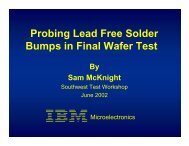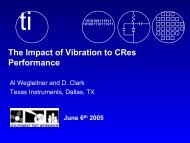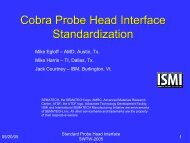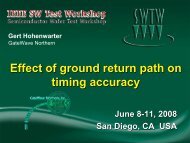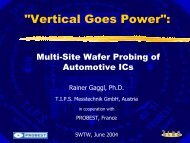Test-data validation - Semiconductor Wafer Test Workshop
Test-data validation - Semiconductor Wafer Test Workshop
Test-data validation - Semiconductor Wafer Test Workshop
Create successful ePaper yourself
Turn your PDF publications into a flip-book with our unique Google optimized e-Paper software.
June 7-10, 2009<br />
San Diego, CA<br />
<strong>Test</strong>-<strong>data</strong> <strong>validation</strong><br />
Rob Marcelis
Understanding <strong>Test</strong>-Data<br />
• Where does the test-<strong>data</strong> come from?<br />
• Part-variance / <strong>Test</strong>-variance<br />
• Artifacts<br />
• Zero defect<br />
• Known good die (bare-die delivery)<br />
June 7 to 10, 2009<br />
IEEE SW <strong>Test</strong> <strong>Workshop</strong> 2
<strong>Test</strong>-Data; where does it come from?<br />
Spec<br />
Design<br />
Product<br />
<strong>Wafer</strong>-map<br />
<strong>Test</strong> program<br />
test<br />
<strong>data</strong><br />
Pass/fail<br />
June 7 to 10, 2009<br />
IEEE SW <strong>Test</strong> <strong>Workshop</strong> 3
<strong>Test</strong> program preparations<br />
• Repeatability<br />
– Run 1 device at least 50 times<br />
– Check variance<br />
• Capabilities<br />
– Cp, Cpk, shape, etc<br />
– Check limits<br />
• Gage R&R<br />
– Use multiple variable; testers, load boards, probe-cards, etc<br />
• When all above is good, production can be tested<br />
• <strong>Test</strong> engineer take all the time for “perfect set-up”<br />
• Is this guaranty for reproducibility ?<br />
June 7 to 10, 2009<br />
IEEE SW <strong>Test</strong> <strong>Workshop</strong> 4
<strong>Test</strong>-Data; where does it come from?<br />
Spec<br />
Design<br />
Product<br />
<strong>Test</strong> program<br />
test<br />
Part variance<br />
<strong>Test</strong> variance<br />
<strong>data</strong><br />
June 7 to 10, 2009<br />
Screening (PAT)<br />
Pass/fail<br />
Adaptive test<br />
IEEE SW <strong>Test</strong> <strong>Workshop</strong> 5
Part variance;<br />
This is where we are interested in!<br />
• In semiconductor industry, the goal is to make all die according<br />
specification & 100% identical!<br />
– Do we succeed in this? No, that is why we test!<br />
– At test, it is the first time you really can check full electric functioning.<br />
• <strong>Test</strong>-program is written to verify proper functioning and confirm<br />
the specifications.<br />
• based upon the test <strong>data</strong> all kind of actions/decisions are made!!<br />
– Pass/fail<br />
– Classification<br />
– SPC<br />
– Etc..<br />
• First production release is done on ideal / perfect set-up<br />
– New probe card, engineering set-up, etc<br />
• But life is not perfect..<br />
June 7 to 10, 2009<br />
IEEE SW <strong>Test</strong> <strong>Workshop</strong> 6
<strong>Test</strong>-engineers are living on the edge!<br />
June 7 to 10, 2009<br />
IEEE SW <strong>Test</strong> <strong>Workshop</strong> 7
<strong>Test</strong> variance<br />
• This is what we don’t want, but have to deal<br />
with!<br />
• Understanding where it comes from;<br />
– Equipment (tester/prober/handler)<br />
– Materials (probe-card/contactor/load-boards/DIB)<br />
– Conditions (temp/humidity/pressure/over-travel Cres/film<br />
resistance)<br />
– <strong>Test</strong>-program (resolution/concessions)<br />
• Can we limit the influence of test variance?<br />
– Prediction<br />
– Correction<br />
June 7 to 10, 2009<br />
IEEE SW <strong>Test</strong> <strong>Workshop</strong> 8
Artifacts<br />
• “An artifact is the error or misrepresentation introduced<br />
by a technique and/or technology” (wikipedia)<br />
• In Semi-Conductor <strong>data</strong>-sets we have artifacts caused<br />
by:<br />
– Reticle dependency<br />
– <strong>Test</strong>-site dependency<br />
– <strong>Test</strong> set-up failures<br />
– Others (not further specified)<br />
• Way to get rid of artifacts;<br />
– Fine tune your test set-up, process<br />
• Some times we have to live with the fact that artifacts<br />
are present.<br />
– Data correction in that case is a good alternative<br />
June 7 to 10, 2009<br />
IEEE SW <strong>Test</strong> <strong>Workshop</strong> 9
Good test set-up<br />
• Calibrate tester before test run<br />
• Calibrate entire test set-up<br />
– Load-board (DIB)<br />
– Connections (Pogo-tower, cable connections)<br />
– examples from previous SWTW presentations<br />
• signal compensation for multi site probing,<br />
– Gert Hohenwarter; RF testing<br />
– Paul O’Neil Cascade MicroTech Europe<br />
• Floor vibration TI, Al Wegleitner<br />
June 7 to 10, 2009<br />
IEEE SW <strong>Test</strong> <strong>Workshop</strong> 10
Add-up; synchronization @ multi-site<br />
June 7 to 10, 2009<br />
IEEE SW <strong>Test</strong> <strong>Workshop</strong> 11
Correlation<br />
• Can correlation-wafer probing increase the<br />
quality of the production?<br />
• <strong>Test</strong> correlation wafer (golden wafer)<br />
– Before testing load the corresponding test-<strong>data</strong>log<br />
– During probing compare each die location between<br />
“golden” parametric values and actual values<br />
• Correlate on bin-level (Pass/Fail)<br />
• Correlate to full parametric distribution level<br />
– Shape of distribution<br />
– Location of distribution (drift)<br />
June 7 to 10, 2009<br />
IEEE SW <strong>Test</strong> <strong>Workshop</strong> 12
First time right vs. Retest<br />
• Ultimate goal: No/Limited retest<br />
• Reduce retest<br />
– Eliminate test variance<br />
– Retest for measurement fails only (no valid<br />
reading)<br />
• Retest recovery analysis<br />
June 7 to 10, 2009<br />
IEEE SW <strong>Test</strong> <strong>Workshop</strong> 13
Probe-card deflection<br />
• Probe-card has influence on test-<strong>data</strong><br />
– Probing at high temperature<br />
• No equal heat distribution while probing<br />
– Increased complexity in probe-cards<br />
• Larger die<br />
• More and more multi side<br />
• More contact pressure required<br />
• Robustness of probe process<br />
– No equal forces on all contacts while probing<br />
• 2006 SWTW Gunther Boehm Feinmetall GmbH<br />
• Sometimes correction of z-height solves these<br />
problems<br />
June 7 to 10, 2009<br />
IEEE SW <strong>Test</strong> <strong>Workshop</strong> 14
Thermal distribution<br />
Ring-carrier<br />
Head-plate<br />
Area where temperature<br />
varies during probing.<br />
This includes the entire<br />
probe-card area<br />
June 7 to 10, 2009<br />
IEEE SW <strong>Test</strong> <strong>Workshop</strong> 15
Know what happens in the prober<br />
June 7 to 10, 2009<br />
IEEE SW <strong>Test</strong> <strong>Workshop</strong> 16
Automatic Z-height correction<br />
• First contact – full contact<br />
– At initialization raise chuck slowly until first needle<br />
contact the die.<br />
– Then raise further until all needles are contacting the die<br />
– Difference in z-height between first and full contact<br />
indicate probe-card/set-up planarity<br />
– Limits on z-height difference protect the set-up against<br />
extensive probe mark damage (cantilever cards)<br />
• First contact – full contact measured under<br />
different conditions (temp) at different locations<br />
(on the chuck) will indicate your probe-card<br />
deflection<br />
June 7 to 10, 2009<br />
IEEE SW <strong>Test</strong> <strong>Workshop</strong> 17
<strong>Test</strong> variance & Multi site probing<br />
• At multi-site probing not all site are equal<br />
– Probe-card layout (site variation)<br />
– <strong>Test</strong>er resources<br />
• Site related test-<strong>data</strong> issues<br />
– Just look at pass fail nothing to worry about, but looking<br />
closer you can detect parametric problems in real time<br />
• Extensive Site to Site R&R is required!<br />
– Verify if all “test-positions” deliver same test results<br />
– To do this on the prober is difficult (time consuming)<br />
June 7 to 10, 2009<br />
IEEE SW <strong>Test</strong> <strong>Workshop</strong> 18
Multi site example<br />
June 7 to 10, 2009<br />
IEEE SW <strong>Test</strong> <strong>Workshop</strong> 19
Production results<br />
June 7 to 10, 2009<br />
IEEE SW <strong>Test</strong> <strong>Workshop</strong> 20
statistics<br />
• <strong>Wafer</strong> 17; the Cpk was suddenly getting down<br />
– separating the sites learned; site-3 was way off<br />
• site 0,1,2 where Cpk value within expectation range<br />
• site 3 Cpk value was much lower<br />
• Looking at pure pass/fail level site-3 was best yielding<br />
site over the entire lot.<br />
• Looking at outlier results, site-3 had a serious test<br />
issue<br />
• off-line analysis process can detect this, but its too<br />
late!<br />
• Real-Time Monitoring Cpk make sense to detect a test<br />
issue.<br />
– Note: For this test; Cpk is relatively high<br />
June 7 to 10, 2009<br />
IEEE SW <strong>Test</strong> <strong>Workshop</strong> 21
wafer-maps<br />
original<br />
total yield<br />
94.25%<br />
PAT-map<br />
total yield<br />
86.64%<br />
site-3<br />
causes<br />
95% of<br />
the total<br />
7.61%<br />
PAT-yield<br />
loss<br />
June 7 to 10, 2009<br />
IEEE SW <strong>Test</strong> <strong>Workshop</strong> 22
An other example of a “site-problem”<br />
<strong>Test</strong> <strong>data</strong> for 1<br />
<strong>Test</strong>, all 4 sites<br />
Same <strong>data</strong> but<br />
With separation<br />
Of the sites<br />
June 7 to 10, 2009<br />
IEEE SW <strong>Test</strong> <strong>Workshop</strong> 23
Control test <strong>data</strong> quality; Make it more ROBUST!<br />
• Automatic verification of test related problems<br />
• <strong>Test</strong>-cell controller shift probe pattern to detect if<br />
“suspected value” move with the site or stay with the<br />
die.<br />
– Dynamic clean<br />
• Clean only then when needed, accepted degrading of<br />
<strong>data</strong>.<br />
– Watch-dog test (critical test)<br />
– RT SPC (values within expectation)<br />
– Correlation<br />
– Trigger tester calibration<br />
• Nice; but how?<br />
June 7 to 10, 2009<br />
IEEE SW <strong>Test</strong> <strong>Workshop</strong> 24
DTC<br />
From SE-PROBE to a Dynamic <strong>Test</strong>-cell Controller<br />
TESTER<br />
DTC SE-PROBE<br />
PROBER /<br />
HANDLER<br />
OEE Module<br />
More to come!<br />
Daemon<br />
Adaptive test<br />
Module<br />
Outlier detection<br />
Module<br />
Datalog Module<br />
Trend Module<br />
Network<br />
switch<br />
Net<br />
June 7 to 10, 2009<br />
IEEE SW <strong>Test</strong> <strong>Workshop</strong> 25
Dynamic <strong>Test</strong>-cell Controller<br />
• <strong>Test</strong>er daemon<br />
– Provide in real-time parametric <strong>data</strong><br />
– No overhead (save time)<br />
– Software on tester workstation<br />
• Data-log module creating the test-<strong>data</strong>-log<br />
• Trend module will monitor selected test(s)<br />
– Dynamic clean<br />
– Detect parametric value getting out of control (RT-SPC)<br />
– Initiate a calibration on the tester<br />
• Prober control<br />
– Control over-travel<br />
– Control movements<br />
June 7 to 10, 2009<br />
IEEE SW <strong>Test</strong> <strong>Workshop</strong> 26
Adaptive test<br />
• Result driven test-flow switching<br />
• Based on Cpk, yield, hard/soft bin fail rate<br />
• Multiple area’s with multiple criteria<br />
• Watch dog test(s) switch back to full flow<br />
when test <strong>data</strong> is not according<br />
expectation.<br />
• Tracking and traceability<br />
– Know what, where, when, how<br />
– Multiple pass bins representing test-flow used<br />
June 7 to 10, 2009<br />
IEEE SW <strong>Test</strong> <strong>Workshop</strong> 27
• On-line Screening<br />
Zero defect<br />
– Part Average <strong>Test</strong>ing<br />
– Nearest Neighborhood Residual<br />
– Good die in bad neighborhood detection<br />
– Data integrity<br />
June 7 to 10, 2009<br />
IEEE SW <strong>Test</strong> <strong>Workshop</strong> 28
esults<br />
• More robust test <strong>data</strong><br />
– Clean on demand<br />
– Reliable <strong>data</strong> for adaptive testing<br />
– Problem detection when it happens<br />
• Stop/pause production ask for assistance<br />
• Auto correct<br />
– Actively correct; over-travel<br />
– Higher Cpk value compared to no test-cell<br />
controller<br />
– Data-log for on-line and off-line screening<br />
June 7 to 10, 2009<br />
IEEE SW <strong>Test</strong> <strong>Workshop</strong> 29
• More robust test-<strong>data</strong><br />
conclusion<br />
– Reduce and control the test-variance / artifacts<br />
• Detection of test-variation influence on-line<br />
– Off-line detection is too late and can result in retest!<br />
• Automatic correction before it result in rejects<br />
• Better <strong>data</strong> integrity<br />
• First-time-right approach<br />
• Field proven solution<br />
June 7 to 10, 2009<br />
IEEE SW <strong>Test</strong> <strong>Workshop</strong> 30
Acknowledgments<br />
• Paul van Ulsen, CEO Salland Engineering<br />
• Salland Engineering DTC development<br />
team<br />
• Several customers shared their findings<br />
• Hilary; for posing “at the edge”<br />
June 7 to 10, 2009<br />
IEEE SW <strong>Test</strong> <strong>Workshop</strong> 31


